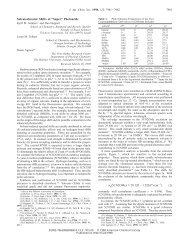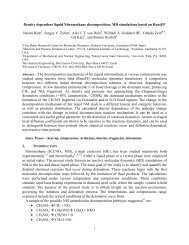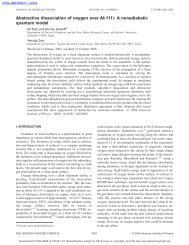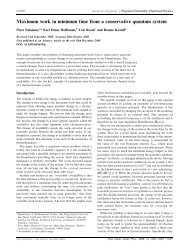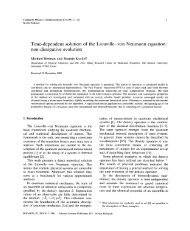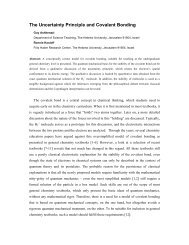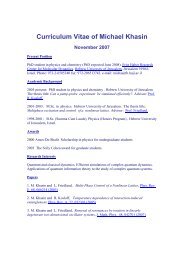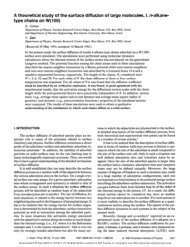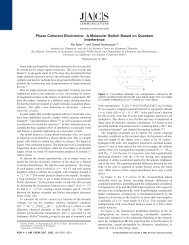Molecular Symmetry Properties of Conical Intersections and ...
Molecular Symmetry Properties of Conical Intersections and ...
Molecular Symmetry Properties of Conical Intersections and ...
Create successful ePaper yourself
Turn your PDF publications into a flip-book with our unique Google optimized e-Paper software.
3000 J. Phys. Chem. A, Vol. 114, No. 9, 2010 Al-Jabour et al.<br />
the set <strong>of</strong> charged CI i,i+1 in its order to assign its IREP. In<br />
brief,<br />
if<br />
Application to our model system C5H4NH with MS group<br />
C2V(M) yields<br />
<strong>and</strong><br />
Γ(CI i,i+1 ) ) Γ h<br />
Pˆ Γh CI i,i+1 ) CI i,i+1<br />
(36)<br />
(37)<br />
Γ(CI i,i+1 ) ) B 1 if i,i+1 ) π/2 (38)<br />
Γ(CI i,i+1 ) ) B 2 if i,i+1 ) 0 (39)<br />
where i,i+1 denotes the “first” conical intersection; see also the<br />
relative signs which are listed for arbitrary objects with<br />
irreducible representations B1 <strong>and</strong> B2 in Table 1, respectively.<br />
J. <strong>Molecular</strong> <strong>Symmetry</strong> Effects on the Topology <strong>of</strong> <strong>Conical</strong><br />
<strong>Intersections</strong>. (x) Finally, we discover an important<br />
consequence <strong>of</strong> items i-ix; i.e., the domains <strong>of</strong> the seams <strong>of</strong><br />
the CIs may be restricted to specific topologies due to molecular<br />
symmetry. As an example, consider the case where CI1 i,i+1 has<br />
been discovered at [{r i,i+1 , i,i+1 ) π/2}]1, implying the<br />
symmetry-adapted CI2 i,i+1 at [{r i,i+1 , i,i+1 )-π/2}]2, cf. Figure<br />
2a. We shall show that, for this scenario, the seam <strong>of</strong> the CIs in<br />
the (r, )-plane are constrained to i,i+1 )(π/2. For this<br />
purpose, let us assume hypothetically that the seam <strong>of</strong> this<br />
conical intersection with symmetry B1 (cf. item ix) includes a<br />
CI which is not located at ) π/2 or )-π/2, as illustrated<br />
by one <strong>of</strong> the hypothetical marks “?” in Figure 2c; application<br />
<strong>of</strong> all symmetry operations would then generate the set <strong>of</strong><br />
analogous CIs at symmetry-related locations; two representatives<br />
<strong>of</strong> these kinds <strong>of</strong> hypothetical CIs are illustrated by<br />
marks “?” in Figure 2c, with corresponding coordinates<br />
{sk i,i+1 } which include the values i,i+1 <strong>and</strong> π - i,i+1 ,<br />
respectively, 0 e i,i+1 < π/2. Figure 2c also shows<br />
symmetry-related contours L4 <strong>and</strong> L5 around these hypothetical<br />
CIs; they contain the same symbols * <strong>and</strong> × as those<br />
shown in Figure 2a. The symmetries <strong>of</strong> the NACTs which<br />
have been determined in item vii yield the same values ()<br />
+π) <strong>of</strong> the contour integrals evaluated along these contours.<br />
Now let us walk from each <strong>of</strong> the hypothetical CIs which<br />
have been sketched in Figure 2c along the hypothetical seam<br />
to the original CI which has been marked by “+” in Figure<br />
2a. Simultaneously, the two loops L4 <strong>and</strong> L5 around the two<br />
individual hypothetical CIs are merged to a single one which<br />
contains two hypothetical CIs. The contour integral along<br />
the single loop is then equal to the sum <strong>of</strong> the individual<br />
loop integrals; i.e., it is equal to +2π. On arrival at the<br />
original CI1 i,i+1 , let the merged loop coincide with the one<br />
shown in Figure 2a. However, we know from item viii that<br />
the loop integral for that single loop is equal to +π, not +2π,<br />
cf. eq 28. This contradiction falsifies the assumption <strong>of</strong> the<br />
hypothetical CIs. The seams <strong>of</strong> the CI1 i,i+1 <strong>and</strong> CI2 i,i+1 are<br />
restricted, therefore, to i,i+1 ) π/2 or -π/2.<br />
Analogous arguments can be applied to the other example<br />
where CI1 i,i+1 has been discovered at i,i+1 ) 0, with the<br />
symmetry-adapted CI2 i,i+1 at (π, cf. Figure 2d. Their seams in<br />
the (r, )-plane are restricted by molecular symmetry to the<br />
values i,i+1 ) 0or(π. Assumptions <strong>of</strong> hypothetical CIs on<br />
the seam at different symmetry-related coordinates i,i+1 <strong>and</strong><br />
- i,i+1 where 0 e i,i+1 < π/2 surrounded by loop L4′ <strong>and</strong> L5′,<br />
as shown in panel 2f, would lead to contradictions, analogous<br />
to the preceding paragraph. By extrapolation, these two examples<br />
show that for specific planes <strong>of</strong> the MS-adapted<br />
coordinates, the seams <strong>of</strong> the CIs may be restricted to specific<br />
values <strong>of</strong> some <strong>of</strong> the symmetry-adapted coordinates, depending<br />
on the symmetry <strong>of</strong> the NACTs <strong>and</strong> CIs.<br />
III. Application <strong>and</strong> Discussions Based on Quantum<br />
Chemistry Results for the Model System C5H4NH<br />
Section II contains the rather general recipe <strong>of</strong> steps i-x for<br />
the determination <strong>of</strong> the IREPs <strong>of</strong> the NACTs <strong>and</strong> CIs, for<br />
molecules with molecular symmetry group supporting 1-d<br />
IREPs. The model system C5H4NH has served as an example;<br />
so far, we have exploited the rather general properties <strong>of</strong> the<br />
corresponding molecular symmetry group C2V(M). In this<br />
section, we shall add quantum chemistry ab initio evaluations<br />
<strong>of</strong> the NACTs in restricted domains, in order to determine the<br />
IREPs <strong>of</strong> the NACTs <strong>and</strong> CIs for the lowest three singlet states,<br />
<strong>and</strong> to explore the topologies <strong>of</strong> the seams <strong>of</strong> the CIs. For a<br />
coherent presentation <strong>of</strong> the results, we shall refer to the previous<br />
items i-x, adding the new ones xi <strong>and</strong> xii.<br />
(i) The molecular symmetry group <strong>of</strong> C5H4NH is C2V(M), cf.<br />
section II.<br />
(ii <strong>and</strong> iii) It is convenient to solve these combined tasks step<br />
by step, as follows:<br />
Step 1: The location <strong>of</strong> the first CI1 0,1 between electronic states<br />
S0 <strong>and</strong> S1 is based on the Longuet-Higgins theorem. 32,33 In<br />
practice, it involves several substeps: 39<br />
First, we employ quantum chemistry to calculate the potential<br />
minima <strong>and</strong> transition states (TS) for the PES <strong>of</strong> the electronic<br />
ground state S0. All <strong>of</strong> the results presented below (also those<br />
for the other PES, the NACTs, the double <strong>and</strong> triple CIs, <strong>and</strong><br />
the seams <strong>of</strong> the CIs) have been obtained at the CAS(10/9)/ccpVDZ<br />
level <strong>of</strong> the CASSCF methodology40 as implemented in<br />
the GAMESS41 <strong>and</strong> MOLPRO42 program suites. The active<br />
space <strong>of</strong> the CASSCF calculations includes 9 molecular orbitals<br />
(MO) occupied by 10 electrons, i.e., all π orbitals (three<br />
occupied π ones <strong>and</strong> three unoccupied π* orbitals), together<br />
with three σ-type MOs (the occupied one for the lone electronic<br />
pair <strong>of</strong> the N atom, the occupied N-H bond MO, <strong>and</strong> the virtual<br />
σ* (mainly N-H) MO). These σ-MOs were taken into account<br />
because the studied syn-anti isomerization involves a change<br />
in hybridization <strong>of</strong> the N atom; see below. The full π-active<br />
space together with these σ orbitals provide an adequate<br />
description for this part <strong>of</strong> the PES, using the st<strong>and</strong>ard cc-pVDZ<br />
basis set. Different from the rest <strong>of</strong> this paper, these CASSCF<br />
calculations employ the “local” molecular point groups <strong>of</strong> these<br />
stationary states, as is adequate for quantum chemistry. The<br />
resulting planar geometry <strong>of</strong> C5H4NH at the potential minimum<br />
is shown in Figure 3; it is called the syn-A′ form <strong>of</strong> C5H4NH,<br />
with IREP A′ for the local Cs symmetry.<br />
The “global” molecular symmetry C2V(M) implies that<br />
C5H4NH possesses an equivalent minimum <strong>of</strong> the PES for the<br />
anti form, again with local IREP A′. The two electronic valence<br />
bond (VB) structures for the syn <strong>and</strong> anti geometries, with<br />
different orientations <strong>of</strong> the lone electron pairs due to sp2 hybridization at the nitrogen, are sketched in Figure 4.<br />
In-plane inversion <strong>of</strong> the CNH fragment <strong>of</strong> C5H4NH from<br />
its syn form to the anti form leads via the transition state for



